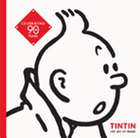
Tintin first burst onto the scene in 1929 as a serialized comic strip in Le Petit Vingtième, the children's supplement of Belgian newspaper Le Vingtième Siècle, and it became one of the most popular comics of the 20th century. The genius behind Tintin's creation was Belgian cartoonist Georges Remi, better known as Hergé. His pioneering use of ligne claire ("clear line"), a drawing style that employs no cross-hatching, inspired the bold architectural design of the Musée Hergé, which is dedicated to his life and art.
Tintin: The Art of Hergé is a remarkable sampling of published and unpublished pieces culled from the museum's extensive collection. These pieces provide insight and perspective on Hergé's prolific career, highlighting the depths and sophistication of his artistry. Hergé "was a self-taught man forced to grapple with his own creation" that "began with a simple idea, which swelled, little by little, to become a great river." Nearly a century later, Tintin continues to influence artists and attract fans. --Nancy Powell, freelance writer and technical consultant

